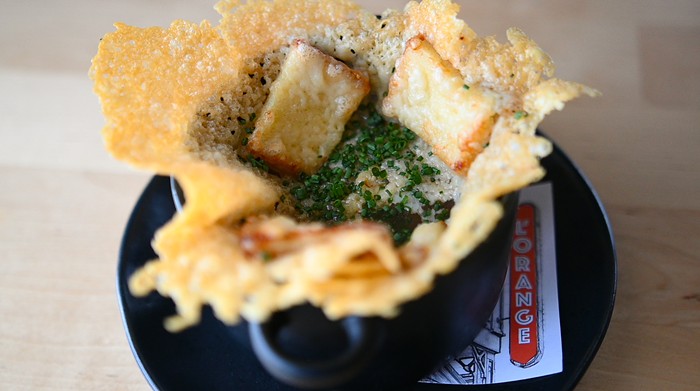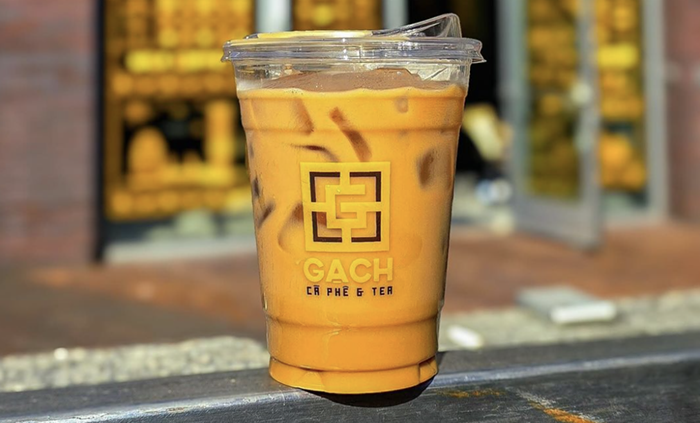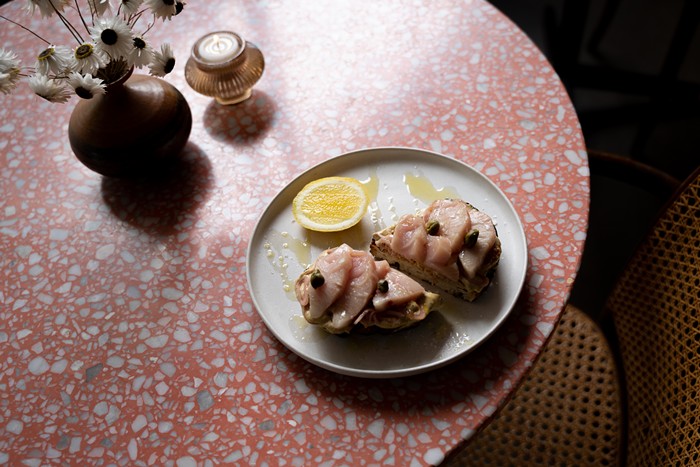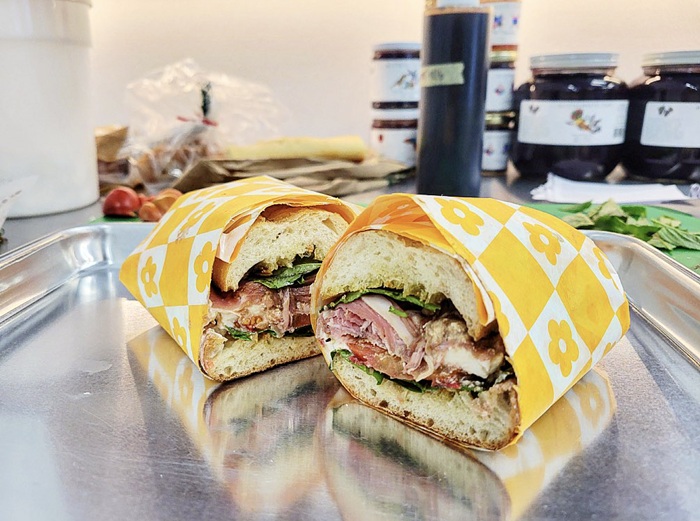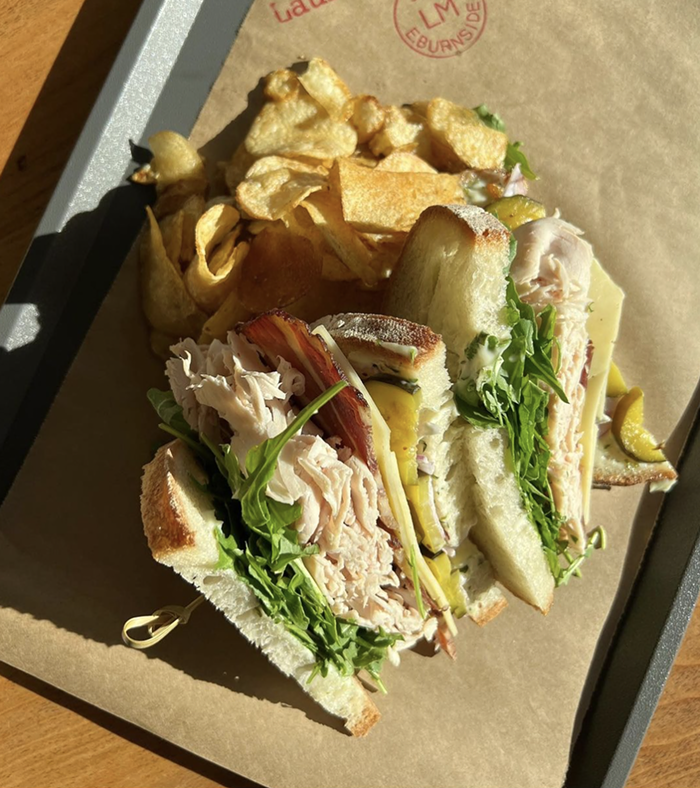Breaking the Mold
Chalino Gets Inventive with Mexican
Döner Kebab Forever
Spitz Specializes in the Turkish Granddaddy of Street Food
Ray, Rain or Shine
Jenn Louis Proves Celebrity-Chef Status with New Israeli Restaurant
Jackrabbit Hops Over the Top
SF Celeb Chef Shows You Can Take Decadence Too Far
There’s a Lot of Thai to Be Thankful For
Farmhouse Thai, Paadee’s Issan Nights, and Pok Pok NW
East European Wines on the Rise
Obscure Wines That Might Just Blow Your Mind
The Jell-O Shot Mega List
The Best Bars for Gettin' Jiggly with It
The Cocktail Explorer’s Club
Local Drinks (and Drinkeries) You Have to Try
Digesting Feast
A Recap of Portland’s Most Popular Food Festival
Interview with the Foodie
Where Gary Okazaki—AKA Gary the Foodie—Sees Portland’s Culinary Scene Going
Brunch Outside the Box
Breaking Out of the Breakfast Rut
Soul Food, Redefined
Salimatu Amabebe’s Nigerian Pop-ups Are Spicing Up Portland’s Vegan Food Scene
The Mercury’s Fall Eat & Drink Guide
Prepare for the Season of Eating!
A Beginner’s Guide to Portland Beer
What to Drink, and Where to Drink It.
Döner kebab is an iconic street food sight: a conical stack of meat cooking on a vertical, rotating spit. Immigration patterns meant that while döner was sticking closer to its Turkish home, becoming ubiquitous in European cities like Berlin and London, its derivative cousins headed to North America. Döner kebab inspired not only Greek gyros and Avengers-approved shawarma, but even, via Lebanese immigrants, the Mexican al pastor preparation.
I was once a 20-year-old American in Europe, delightedly devouring döner. So the first time I ate at Spitz, at its birth home in Los Angeles, I wasn’t quite a neophyte. It was, however, my first time in LA. And even then, nearly a decade into Spitz’s reign, it was frequently recommended to me by the locals. That local passion has since turned Spitz into a small chain with locations in four states.
Angelino and Spitz vet Fernando Del Valle, along with Portlander Christopher Retzer, have now brought Spitz to Portland, where they churn out the döner with consistency and speed. (The food comes out quick, though it may take a while to place an order. Spitz is large, but only offers counter service, and typically with only one register. Expect lines at unpredictable times.)
The basic döner is wrapped in thin flatbread and tightly bound with waxed paper, but still packed with lettuce, veggies, and, for some reason, never quite enough sauce. The street cart döner comes with aioli and fried lavash chips inside, but the Döner with Pommes—packed with fries—is the jam. There’s a Mediterranean one with a sweetish hummus and olives, and a spicy döner with pepperoncinis and chili sauce (all $9.75 meat/falafel, $9.25 veggie).
The meat (lamb/beef, chicken, or a mix) is complexly seasoned, juicy, and plentiful—though it’s kept in a closed kitchen, which undercuts the spectacle of spinning döner. (Watching it rotate as they carve long strips off is borderline hypnotic.) The falafel isn’t as flavorful, but it’s not bad by any means, and neither is it dry or chalky. Across the board, the wraps are tasty but undersauced. (I asked my friend how spicy his spicy döner was, and he answered, “I don’t know, how spicy is a pepperoncini?”)

The same ingredients are available on top of fries (regular or sweet potato, $8.50, $11.50 with meat/falafel), in a huge döner salad ($12 with meat, $10.50 without), or a döner basket, which is basically the salad with French fries in it ($12.50). But my favorite of the non-wrap dishes is the Döquitos, which apes a taquito or flauta, and is more or less a thinner version of the wrap, fried and then covered with whatever ingredients didn’t fit inside ($5 for one, two for $9). There are even brunch versions on the weekend, and a “hangover basket,” which is basically all that plus eggs and American cheese (best $11 you can possibly spend).
The Crispy Garbanzo with Olives is a sleeper hit: A bowl of fried chickpeas is no-brainer snacking food, but fried olives—somehow not quite crisp but airy, soft, and dry—make it a can’t-miss. The fried pita strips are less impressive and maybe a touch too oily, but worth it to scoop up your (or your neighbor’s) scraps ($4 small, $6 large—small is plenty).
There’s something to be said for a menu that’s virtually all the same ingredients with a few key changes. It’s an acknowledgment that there are wrong ways to do this, despite all the right ways. And it avoids the inevitable let-down of the mix-your-own model.
Spitz serves beer and wine, though cocktails are hit-or-miss. A lackluster cucumber margarita had me feeling blue, but the Bomb G&T is whatever kids say instead of “the bomb” now ($11).

The off-putting thing about LA is that it feels overtly designed and marketed, but overtness is the whole point of LA. Image is industry there, so can you complain that the “street art” at Spitz feels false? It’s hard to call the Fight Club stencils and decorative record sleeves pretentious when they clearly aren’t pretending at anything. Even Los Angeles isn’t Los Angeles—it’s a Los Angeles-themed stretch of beach and desert. Spitz is simply another iteration of that theme, applied to a döner restaurant.
Spitz seems to be holding strong in its moderately cursed location next door to North Killingsworth whiskey bar the Old Gold. Previous restaurants in the space offered either an underwhelming concept (New American), or too upscale a menu (Mextiza) and never took full advantage of the space.
It may still be hard for some Portlanders to stomach that skin-deep LA sheen. But just as the Old Gold succeeds largely because its concept appears to be “good neighborhood bar” (the exceptional whiskey selection is arguably a bonus), Spitz capitalizes on a similar goal. At its heart, it’s a casual spot with unique-enough but crowd-pleasing food, a kids’ meal (with a juice box! $6), bright decor, board games, and a comfy patio. And with the Old Gold next door, Spitz finally lets 2103 North Killingsworth feel like it fills its own place in the neighborhood.

